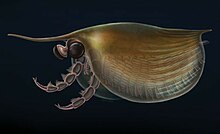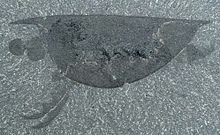Isoxys
| Isoxys Temporal range:
| |
|---|---|

| |
| Isoxys curvirostratusfrom the Chengjiang Biota | |

| |
| Fossil ofIsoxys acutangulusfrom the Burgess Shale | |
| Scientific classification | |
| Domain: | Eukaryota |
| Kingdom: | Animalia |
| Phylum: | Arthropoda |
| Order: | †Isoxyida |
| Family: | †Isoxyidae |
| Genus: | †Isoxys Walcott,1890 |
| Species | |
|
See text | |
Isoxys(meaning "equal surfaces" ) is agenusofextinctbivalvedCambrianarthropod;the various species of which are thought to have been freely swimming predators.[1]It had a pair of large spherical eyes (which are the most commonly preserved feature of the soft-bodied anatomy),[2]and two large frontal appendages used to grasp prey.[1]
Description
[edit]
Species ofIsoxyshave roughly semicircular bivalved carapaces, which vary in morphology between species. The front and rear edges of the carapaces bear forward and posterior facing spines, respectively which in some species are greatly elongated.[3]The carapaces ofIsoxysare typically 1.1 to 3.3 centimetres (0.43 to 1.30 in) in length, excluding the spines, though some species are known to reach over 6 centimetres (2.4 in). In long-spined species when including spine length, some specimens exceed 10 centimetres (3.9 in).[4]The opening angle of the carapace was close to vertical, giving it a narrow profile when viewed from above.[3]
The head had a pair of large spherical stalked eyes, as well as a pair of upward-curling frontal appendages, which have a varying number of podomeres/segments, depending on the species. Most podomeres on the frontal appendages have upward-facingenditespines, with the number and placement of spines varying between species. The last podomere of the frontal appendage is a curved terminal claw. The trunk lacks clear segmentation (arthrodization). Along the body are pairs ofbiramous appendages,the counts of which differ between species (Isoxys curvirostratushas 14, whileIsoxys auritushas 11). InIsoxys curvirostratustheendopodshave well defined segments/podomeres. The first four biramous limb pairs ofIsoxys curvirostratuswere shorter than the remaining pairs, with their endopods having borne well developedendite(inward facing) spines and ended with a curved subchela (claw), with these features absent in the endopods of the more posterior limbs. TheexopodsofIsoxys curvirostratushad thick paddle-shaped lamellae which projected perpendicular to the limb axis.[5]Isoxys volucrisfrom Greenland had paddle-shaped exopods suggested to have been fringed withsetae.[6]The end of the trunk has pairedtelsonflaps.[5]
Ecology
[edit]Species ofIsoxysare thought to have been actively swimming predators, using its frontal appendages to capture soft-bodied prey, with the frontalmost pairs of biramous limbs aiding in food processing.[5]The variousIsoxysspecies are thought to have occupied a variety of niches, from swimming just above the seafloor (nektobenthic) to open ocean swimmers (pelagic).[3]Swimming was likely accomplished by rhythmic movement of the legs.[5]Eyes of different specimens appear to have been adapted to different light intensities; one specimen ofI. aurituswas either crepuscular in shallow water, or lived in waters around 140 m below the sea surface; whereas another was morphologically adapted to a diurnal light intensity in shallow waters.[7]Isoxysspecies with elongated carapace spines are likely to have engaged invertical migrationup and down the water column, like many modern marine invertebrates.[3]Specimens ofIsoxys minorhave been found with eggs adhered to the inner surface of the carapace, indicating they engaged in brood care. The brood size was large, with approximately 300 eggs, each0.5 millimetres (3⁄128in) across per (presumably female) individual. Egg bearing individuals were only around half the maximum size, suggesting that individuals continued to grow beyond sexual maturity.[8]
Taxonomy
[edit]
Isoxysis thought to be one of thebasalmostknownstem-grouparthropods, showing a combination of traits characteristic of moreprimitivestem-grouparthropods likeradiodonts,like lacking an arthrodized (sclerotizedand jointed) trunk exoskeleton, with those of modern arthropods, like possessing sclerotized and jointed (arthropodized)biramouslimbs. It is one of two genera within the familyIsoxyidae,alongsideSurusicaris.[5]A close relationship to the bivalved arthropodTuzoiahad historically been proposed based on the similarities of some aspects of their carapaces,[9]but preserved soft tissues ofTuzoiadescribed in 2022 suggest that they are not closely related.[10]
Species
[edit]20 species ofIsoxyshave been described,[3]which have a global distribution, having been found in North America, Siberia, Australia, China and Europe, spanning fromCambrian Series 2into theMiaolingian.[11]
- Isoxys chilhoweanusWalcott, 1890 (type)Tennessee,USA,Cambrian Series 2
- Isoxys acutangulus(Walcott, 1908)Balang Formation,Guizhou,China,Cambrian Stage 4,Burgess Shale,Canada,Miaolingian
- Isoxys auritus(Jiang, 1982)Chengjiang Biota,Yunnan,China,Cambrian Stage 3,Balang Formation, China, Cambrian Stage 4
- IsoxyscurvirostratusVannier & Chen, 2000Chengjiang Biota, China, Cambrian Stage 3
- IsoxysparadoxusHou, 1987Chengjiang Biota, China, Cambrian Stage 3
- IsoxyszhurensisIvantsov, 1990Sinsk Formation,Siberia,Cambrian Series 2
- Isoxys bispinatusCui, 1991Shuijintuo Formation,Sichuan,China, Cambrian Series 2
- Isoxys glaessneriGarcía−Bellido, Paterson, Edgecombe, Jago, Gehling & Lee, 2009Emu Bay Shale,Australia, Cambrian Stage 4
- IsoxyscommunisGlaessner, 1979Emu Bay Shale,Australia, Cambrian Stage 4
- Isoxys guanduensisWang et al., 2012Guanshan Biota,Yunnan, China, Cambrian Stage 4
- IsoxysminorLuo et al., 2008Guanshan Biota, Yunnan, China, Cambrian Stage 4
- IsoxyswudingensisLuo & Hu, 2006Guanshan Biota, Yunnan, China, Cambrian Stage 4
- Isoxys globulusLiu et al., 2018Balang Formation, Guizhou, China, Cambrian Stage 4
- Isoxys jianheensisLiu et al., 2018Balang Formation, Guizhou, China, Cambrian Stage 4
- Isoxys volucrisWilliams, Siveter & Peel, 1996,Sirius Passet,Greenland, Cambrian Stage 3
- Isoxys mackenziensisKimmig & Pratt 2015Rockslide Formation,Canada, Miaolingian
- Isoxys longissimusSimonetta & Delle Cave, 1975Burgess Shale, Canada, Miaolingian
- IsoxyscarbonelliRichter & Richter, 1927,Pedroche Formation,Spain, Cambrian Series 2
- Isoxys shandongensisWang and Huang, 2010,Mantou Formation,Shandong, China, Miaolingian
Indeterminate species are also known from theSpence Shaleof Utah, dating to the Miaolingian, as well as theKaili Biotain Guizhou, China, which also dates to the Miaolingian.[11]
See also
[edit]References
[edit]- ^abVannier, J.; Garcia-Bellido, C.; Hu, X.; Chen, L. (Jul 2009)."Arthropod visual predators in the early pelagic ecosystem: evidence from the Burgess Shale and Chengjiang biotas".Proceedings: Biological Sciences.276(1667): 2567–2574.doi:10.1098/rspb.2009.0361.ISSN0962-8452.PMC2686666.PMID19403536.
- ^García-Bellido, D.; Vannier, J.; Collins, D. (2009)."Soft-part preservation in two species of the arthropod Isoxys from the middle Cambrian Burgess Shale of British Columbia, Canada"(PDF).Acta Palaeontologica Polonica.54(4): 699.doi:10.4202/app.2009.0024.S2CID53613716.
- ^abcdePates, Stephen; Daley, Allison C.; Legg, David A.; Rahman, Imran A. (2021-06-30)."Vertically migrating Isoxys and the early Cambrian biological pump".Proceedings of the Royal Society B: Biological Sciences.288(1953): 20210464.doi:10.1098/rspb.2021.0464.PMC8220267.PMID34157876.
- ^García-Bellido, Diego C.; Paterson, John R.; Edgecombe, Gregory D.; Jago, James B.; Gehling, James G.; Lee, Michael S. Y. (November 2009)."The bivalved arthropods Isoxys and Tuzoia with soft-part preservation from the Lower Cambrian Emu Bay Shale Lagerstätte (Kangaroo Island, Australia): Isoxys and Tuzoia From Emu Bay Shale (Australia)".Palaeontology.52(6): 1221–1241.doi:10.1111/j.1475-4983.2009.00914.x.S2CID129374179.
- ^abcdeZhang, Caixia; Liu, Yu; Ortega-Hernández, Javier; Wolfe, Joanna; Jin, Changfei; Mai, Huijuan; Hou, Xian-guang; Guo, Jin; Zhai, Dayou (19 April 2023)."Three-dimensional morphology of the biramous appendages in Isoxys from the early Cambrian of South China, and its implications for early euarthropod evolution".Proceedings of the Royal Society B: Biological Sciences.290(1997).doi:10.1098/rspb.2023.0335.PMC10113025.PMID37072042.
- ^Stein, Martin; Peel, John S.; Siveter, David J.; Williams, Mark (2009-09-07)."Isoxys (Arthropoda) with preserved soft anatomy from the Sirius Passet Lagerstätte, lower Cambrian of North Greenland: Isoxys with soft anatomy from Greenland".Lethaia.43(2): 258–265.doi:10.1111/j.1502-3931.2009.00189.x.
- ^Schoenemann, B.; Clarkson, E. N. K. (2010). "Eyes and vision in the Chengjiang arthropod Isoxys indicating adaptation to habitat".Lethaia.44(2): no.doi:10.1111/j.1502-3931.2010.00239.x.
- ^Ma, Jiaxin; Pates, Stephen; Wu, Yu; Lin, Weiliang; Liu, Cong; Wu, Yuheng; Zhang, Mingjing; Fu, Dongjing (2023-05-25)."Ontogeny and brooding strategy of the early Cambrian arthropod Isoxys minor from the Qingjiang biota".Frontiers in Ecology and Evolution.11.doi:10.3389/fevo.2023.1174564.ISSN2296-701X.
- ^Ma, Jiaxin; Lin, Weiliang; Liu, Cong; Sun, Ao; Wu, Yu; Wu, Yuheng; Fu, Dongjing (January 2022)."A new bivalved arthropod from the Cambrian (Stage 3) Qingjiang biota expands the palaeogeographical distribution and increases the diversity of Tuzoiidae".Journal of the Geological Society.179(1): jgs2020–229.Bibcode:2022JGSoc.179..229M.doi:10.1144/jgs2020-229.ISSN0016-7649.S2CID236289449.
- ^Izquierdo-López, Alejandro; Caron, Jean-Bernard (December 2022)."The problematic Cambrian arthropod Tuzoia and the origin of mandibulates revisited".Royal Society Open Science.9(12): 220933.Bibcode:2022RSOS....920933I.doi:10.1098/rsos.220933.ISSN2054-5703.PMC9727825.PMID36483757.
- ^abLiu, S.; Peng, J.; Wen, R.; Liang, B. (2018-06-30)."New data for Isoxys of the Balang Fauna (Cambrian Stage 4), South China".Bulletin of Geosciences:147–162.doi:10.3140/bull.geosci.1673.ISSN1802-8225.S2CID134294843.
External links
[edit]- "Isoxys acutangulus".Burgess Shale Fossil Gallery.Virtual Museum of Canada. 2011. Archived fromthe originalon 2020-11-12.Retrieved2023-01-21.
